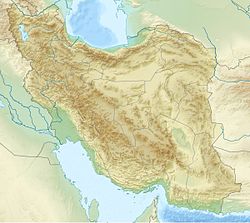| Sardar Mosque | |
|---|---|
مسجد سردار | |
 The mosque interior in 2017 | |
| Religion | |
| Affiliation | Shia Islam |
| Ecclesiastical or organisational status | Mosque |
| Status | Active |
| Location | |
| Location | Urmia, West Azerbaijan province |
| Country | Iran |
Location of the mosque in Iran | |
 | |
| Geographic coordinates | 37°32′59″N 45°4′18″E / 37.54972°N 45.07167°E |
| Architecture | |
| Type | Mosque architecture |
| Style | |
| Completed |
|
| Specifications | |
| Interior area | 22 by 18 m (72 by 59 ft) |
| Dome(s) | One (maybe more) |
| Minaret(s) | One (clock tower) |
| Materials | Bricks; stone; tiles |
| Official name | Sardar Mosque |
| Type | Built |
| Designated | 1 July 1996 |
| Reference no. | 1738 |
| Conservation organization | Cultural Heritage, Handicrafts and Tourism Organization of Iran |
The Sardar Mosque (Persian: مسجد سردار; Arabic: مسجد سردار), variously spelled as the Saat Mosque, the Saatlu Mosque, and the Saatloo Mosque, is a Shi'ite mosque, located on Imam Street, near the Menareh Mosque, in Urmia,[a] in the province of West Azerbaijan, Iran. The mosque was commenced in c. 1810s CE, during the Qajar era[1] and completed in 1912 CE, during the Pahlavi era.[2][3][4]
The mosque was added to the Iran National Heritage List on 1 July 1996, administered by the Cultural Heritage, Handicrafts and Tourism Organization of Iran.
Overview
[edit]The mosque was constructed during the Qajar period. In 1951 CE, a huge clock was affixed on the entrance and was then reputedly known as the Sa'atloo Mosque. It has interesting architectural design which was constructed of brick during the Qajar period. The mosque is in two sections, the basement and a long hall. The brick mosque has a 22-metre (72 ft) shabestan with twelve stone octagonal decorated pillars. The walls of the shabestan are covered in green tiles. There is a border of pink, white, blue, yellow and green colored tiles with floral motifs. A small entrance connects the large Shabistan to a smaller one that has no ornate decorations.[5]
There is a small mehrab with colorful tilework and Quranic inscriptions on the southern part of the shabastan. The other designs and beauty of this mosque, the rainbow tiles which are designed with blue, pink, green, white and brown color and Ayat-Al-Korsi is written inside one of the margins around the mehrab.[5]
Gallery
[edit]- The mosque clocktower
See also
[edit]Notes
[edit]- ^ Also spelled as Orumieh.
References
[edit]- ^ "Sardar Mosque". Tishineh Tourism: Iran. n.d. Retrieved April 29, 2025.
- ^ "Encyclopaedia of the Iranian Architectural History". Cultural Heritage, Handicrafts and Tourism Organization of Iran. May 19, 2011. Archived from the original on April 6, 2015.
- ^ "Sardar Mosque". Tasnim News Agency. Retrieved July 31, 2019.
- ^ "Sardar Mosque". www.toiran.com/en. Retrieved July 31, 2019.
- ^ a b "Sardaar Mosque in Oroumiyeh". Iran Tourism and Touring Organization. 2025. Retrieved April 29, 2025.
External links
[edit]![]() Media related to Sardar Mosque (Urmia) at Wikimedia Commons
Media related to Sardar Mosque (Urmia) at Wikimedia Commons


 Français
Français Italiano
Italiano






